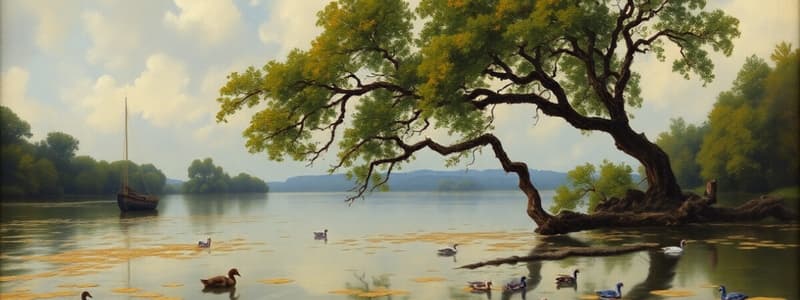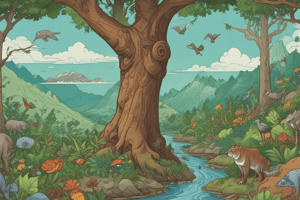Podcast
Questions and Answers
In a food chain, what is the primary role of decomposers like fungi and bacteria?
In a food chain, what is the primary role of decomposers like fungi and bacteria?
- To provide a food source for primary consumers.
- To hunt and consume other organisms for energy.
- To break down dead organic matter and recycle nutrients back into the ecosystem. (correct)
- To convert solar energy into chemical energy through photosynthesis.
If a food chain consists of grass → rabbit → snake → hawk, what trophic level does the snake occupy?
If a food chain consists of grass → rabbit → snake → hawk, what trophic level does the snake occupy?
- Secondary consumer (correct)
- Tertiary consumer
- Primary producer
- Primary consumer
In a balanced ecosystem, what is the primary role of producers?
In a balanced ecosystem, what is the primary role of producers?
- Converting inorganic compounds into energy-rich organic compounds. (correct)
- Breaking down dead organic matter to recycle nutrients.
- Regulating the population size of consumers.
- Consuming other organisms to obtain energy.
Which of the following organisms would be classified as a primary consumer in a typical ecosystem?
Which of the following organisms would be classified as a primary consumer in a typical ecosystem?
In an aquatic food chain consisting of phytoplankton → zooplankton → fish → shark, what happens to the energy as it transfers from the phytoplankton to the shark?
In an aquatic food chain consisting of phytoplankton → zooplankton → fish → shark, what happens to the energy as it transfers from the phytoplankton to the shark?
Which of the following organisms would be classified as a primary consumer in an ecosystem?
Which of the following organisms would be classified as a primary consumer in an ecosystem?
An organism that consumes both plants and animals is classified as what type of consumer?
An organism that consumes both plants and animals is classified as what type of consumer?
If a forest ecosystem experiences a drastic reduction in the producer population, what is the most likely short-term consequence?
If a forest ecosystem experiences a drastic reduction in the producer population, what is the most likely short-term consequence?
Which process is most closely associated with producers?
Which process is most closely associated with producers?
What is the key difference between a decomposer and other types of consumers in an ecosystem?
What is the key difference between a decomposer and other types of consumers in an ecosystem?
In a marine ecosystem, algae and seaweed are primary producers. What critical role do they fulfill?
In a marine ecosystem, algae and seaweed are primary producers. What critical role do they fulfill?
In a forest ecosystem, a caterpillar eats leaves, a bird eats the caterpillar, and a fox eats the bird. If only 10% of energy is transferred at each trophic level, what percentage of the energy originally captured by the leaves is available to the fox?
In a forest ecosystem, a caterpillar eats leaves, a bird eats the caterpillar, and a fox eats the bird. If only 10% of energy is transferred at each trophic level, what percentage of the energy originally captured by the leaves is available to the fox?
How does the energy obtained by a coyote differ based on whether it consumes a rabbit (consumer) or decomposes a dead tree (decomposer)?
How does the energy obtained by a coyote differ based on whether it consumes a rabbit (consumer) or decomposes a dead tree (decomposer)?
Why are there generally fewer top-level consumers (like lions or sharks) compared to primary producers (like grass or algae) in an ecosystem?
Why are there generally fewer top-level consumers (like lions or sharks) compared to primary producers (like grass or algae) in an ecosystem?
What is the key difference between how producers and consumers obtain energy in an ecosystem?
What is the key difference between how producers and consumers obtain energy in an ecosystem?
Flashcards
Producers
Producers
Organisms that make their own food using inorganic molecules.
Photosynthesis
Photosynthesis
The process where producers use sunlight to create food.
Chemosynthesis
Chemosynthesis
The process where some bacteria use chemicals to produce energy instead of sunlight.
Consumers
Consumers
Signup and view all the flashcards
Autotrophs
Autotrophs
Signup and view all the flashcards
Heterotrophs
Heterotrophs
Signup and view all the flashcards
Food Chain
Food Chain
Signup and view all the flashcards
Food Web
Food Web
Signup and view all the flashcards
Herbivores
Herbivores
Signup and view all the flashcards
Carnivores
Carnivores
Signup and view all the flashcards
Omnivores
Omnivores
Signup and view all the flashcards
Decomposers
Decomposers
Signup and view all the flashcards
Detritus Feeders
Detritus Feeders
Signup and view all the flashcards
Scavengers
Scavengers
Signup and view all the flashcards
Study Notes
- All living organisms need to take in energy to live and grow.
- Many different food chains interconnect, forming complex food webs in ecosystems.
Producers
- Producers, also called autotrophs, create their food from inorganic molecules like water, CO2, nitrogen, and phosphate.
- Most producers get their energy from the sun and change inorganic molecules into complex carbohydrates like sugars and starches for food, this is photosynthesis.
- Some bacteria that live deep within the ocean use chemosynthesis to produce energy, as sunlight cannot reach them.
- Producers are the base or first level in all food chains.
- There are many more producers in a food chain than consumers or decomposers.
- Only 10% of the energy from each energy level is passed on to the next energy level.
- Examples include trees, shrubs, grass, algae, lichen, seaweed, and some bacteria.
- Algae, including seaweed, are the primary producers for most aquatic ecosystems.
- In Arctic ecosystems, lichens are the primary producers.
Consumers
- Consumers, also called heterotrophs, do not produce their food but eat other organisms to obtain energy.
- In the food chain, a consumer can be at the second, third, fourth, or even higher energy levels.
- As energy goes up the food chain, only around 10% is passed up to the next level.
- Consumers fall into three groups: herbivores, carnivores, and omnivores.
- Herbivores eat only plants, carnivores eat only other animals, and omnivores eat both plants and animals.
- Consumers can include mammals, birds, fish, reptiles, amphibians, insects, fungi, and some types of bacteria.
- Examples of herbivores are rabbits, dears, cows, elephants, and sheep, and many fish; they are considered a first-level consumer.
- Carnivores include lions, tigers, snakes, sharks, spiders, and sea stars; they eat only meat and can be second, third, fourth, or higher-level consumers.
- Omnivores include bears, dogs, raccoons, insects, and people; they can be second, third, fourth, or more levels of consumers.
Decomposers
- Decomposers break down dead and decaying organic matter; they are also considered heterotrophs.
- A saprophyte is another name for decomposers, especially fungus or bacteria, that live on dead or decaying organisms.
- They break apart organic material back into elemental substances of water, CO2, nitrogen, calcium, and phosphorus.
- Decomposers do not have a predator/prey relationship.
- They do not actively hunt or trap their food but use what is already dead for their food source.
- Most decomposers are microscopic organisms.
- The two main categories are detritus feeders and scavengers.
- Detritus feeders include earthworms, sowbugs, bacteria, fungi, and molds; they break down organic matter to be used again in the ecosystem.
- Scavengers include buzzards, ants, and termites in the desert ecosystem; they tear apart and digest animals for energy.
- Mushrooms do not have any chlorophyll, so they cannot produce their food.
Food Chain
- Grass is eaten by the bee, who is a primary consumer and herbivore.
- The wasp, a secondary consumer, and carnivore get its energy when it eats the bee.
- Next, a frog, a third-level consumer, and a carnivore will get its energy from consuming the wasp.
- The frog is eaten by the snake, a fourth-level consumer, and a carnivore.
- The hawk, a fifth-level consumer, and carnivore will get its energy by eating the snake.
- Finally, the hawk will die someday and possibly be eaten by a buzzard, earthworms, and bacteria (decomposers).
- At each level of the food chain, only 10% of the energy gets passed up the chain to the next level.
- The amount of energy that reaches the buzzard is only.001% of the original amount of energy taken up by the grass.
Studying That Suits You
Use AI to generate personalized quizzes and flashcards to suit your learning preferences.




